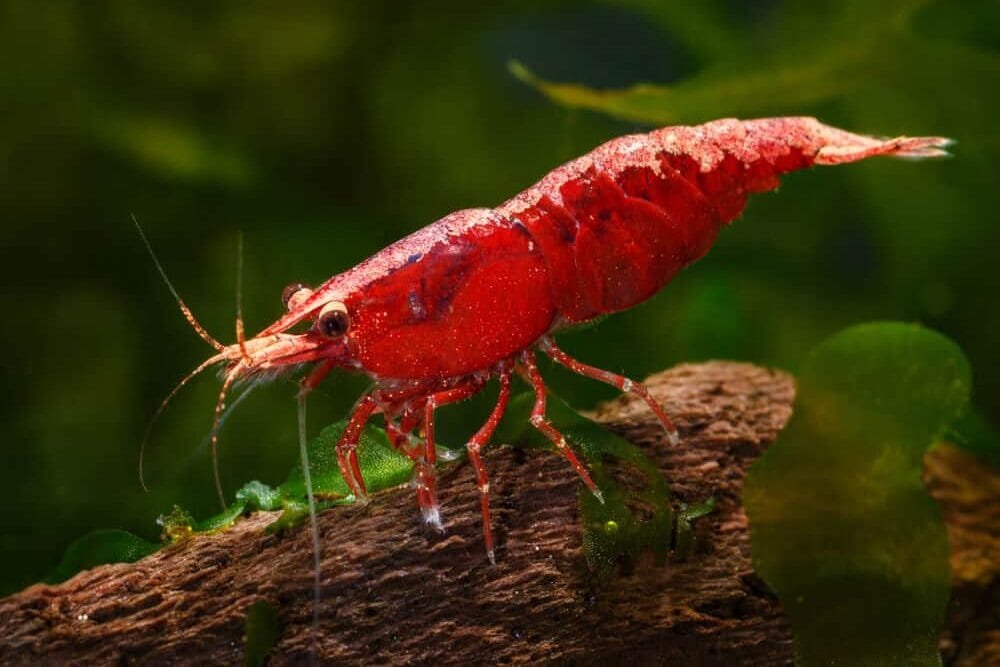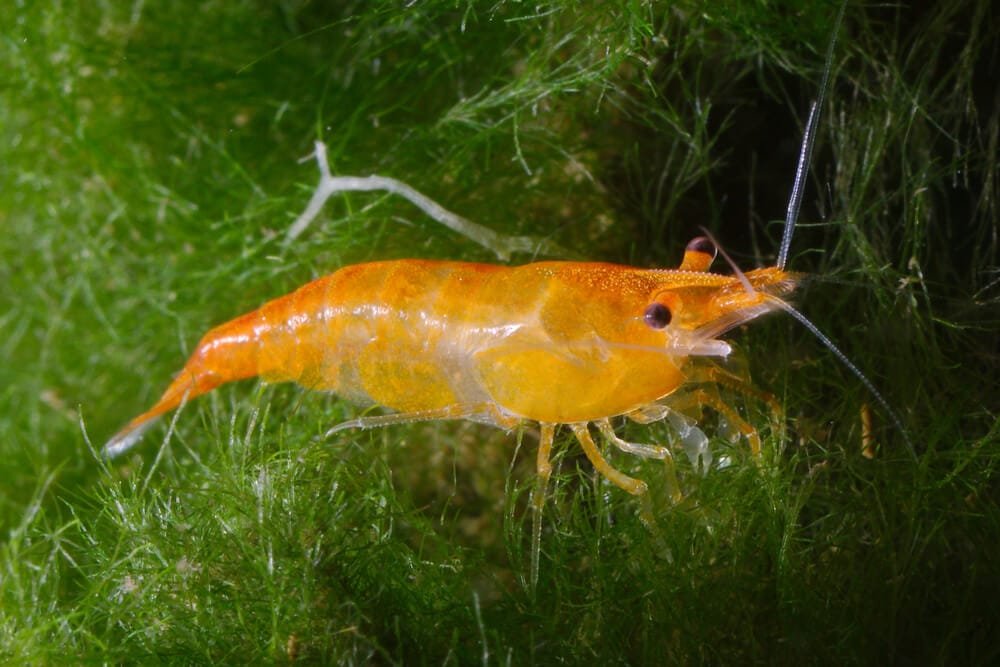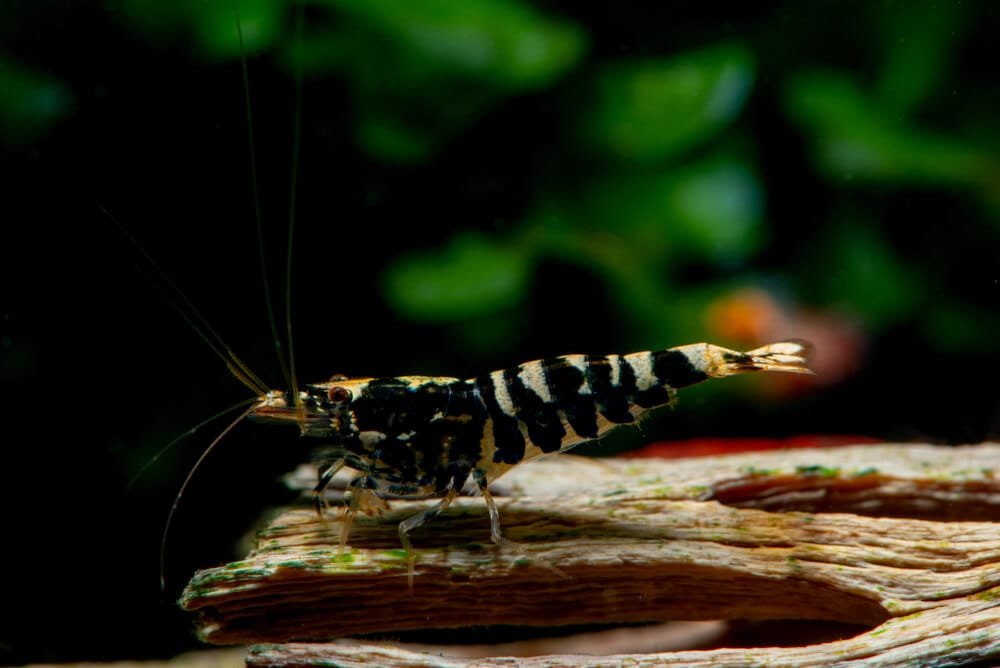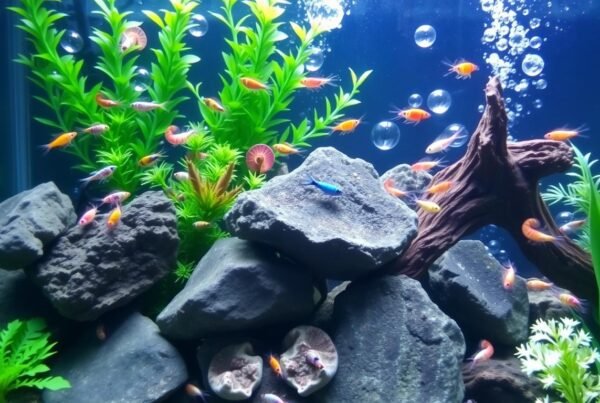Scientific Name: Neocaridina Heteropoda
Family: Atyidae
Origin: Taiwan
Diet: Omnivore
Care Level: Easy
Lifespan: Up to 2 years
Temperament: Peaceful
Minimum Tank Size: 5 Gallons
Temperature Range: 65 – 73 Degrees F
PH Range: 6.5 – 7.5
Water Type: Freshwater
Compatibility: Peaceful community tank mate
Cherry shrimp are a popular and colorful aquarium fish. They live in freshwater lakes, tanks, and ponds. They are considered to be one of the easiest and most beautiful freshwater aquarium fish to grow.
However, caring for the shrimp is not an easy task because the fish is sensitive to water changes in the tank, and great care must be exercised.
But once you hack the care guide, shrimp keeping becomes easy. Here is what you should know about this beautiful water creature.
Species Overview
The red shrimps are freshwater crustaceans that are commonly found in streams and ponds in Taiwan. They have a bright red color that can be seen when they are alive and well.
These shrimps are members of the family Atyidae. The red shrimps are omnivorous, meaning that they eat both plant matter and animal matter.
Red Shrimp, also known as Neocaridina heteropoda, are a popular choice for aquarium hobbyists and are easy to maintain.
They can be introduced to an established aquarium as a food source or can be purchased directly from a pet store.
There are many different types of red shrimps that you can find in pet stores, but there are only a few species that will make good aquarium pets.
If the shrimps are well maintained in the aquarium, they can live for up to two years.
Appearance And Color
Cherry Shrimps come in a wide variety of colors, from brown to green to violet, and even blue.
Red is their most common color but there are some that will be a mixture of red and white, usually around their head. Some may also have an orange tint on the sides of their bodies.
The adult females are bright red in color, with dark tails and distinctive black spots on their bodies.
Cherry Shrimps, grow up to 1 ½ inch in length but the females can be a bit bigger and more colorful than the males. Whenever the environment is not conducive the shrimp will get stressed and might change their coloration.
When the shrimps are young it is hard to differentiate the males and the females.
However, when they mature you can differentiate them by the presence of an orange saddle which can be seen under the tail.
The tail of the male shrimp also appears to be a bit narrower than the female. The female one is wider because it has to carry the eggs.
It is good to keep in mind that the red color of the shrimp changes because of the selective breeding that they have undergone over time. Nonetheless, the red color of the shrimps is more solid in the shade than in the wild.
Therefore, you can expect to have a wide range of colors for the shrimps in the wild than those that are kept in their aquarium. For the purposes of grading the color of the shrimps, four color grades are used.
High grade: This is the highest grade that groups the color of the shrimps. The body is fully covered in red including the legs. An example of this grade is the Painted fire red shrimp. It is also the costliest of the four grades.
Medium-high grade: In this case, only the body part is dark red.
Medium grade: In this case, the body of the shrimp has spots of red color.
Lowest grade: In this case, very few parts of the body are covered in red. Because of its low-grade color, it is the cheapest of the red shrimps.
Sakura falls under this category and will appear to be slightly red. They can also appear to be somehow transparent with red dots. In other cases, they can be translucent with traces of red.
As mentioned above, the price of the shrimp will largely depend on the color grade. Additionally, the highest grade will require high-quality care, especially in terms of water parameters.
Therefore, the highest grade might be costly to keep. Nonetheless, aquarists are more likely to go for the highest grade because of their more attractive appearance.

Tank Setup
Since the shrimps are very small you can choose the size of the tank that you want depending on the number of shrimps you want to keep.
However, an ideal tank for these water creatures is a 5-gallon tank that can accommodate a group of them.
It is important to consider a larger tank that will avoid overcrowding so that your shrimps can thrive well. If you have a bigger tank, it will be easier for you to control the water parameters.
The shrimps are very sensitive to ammonia and nitrates. Therefore, it is important to have an efficient filtration system that will accommodate bio media and process wastes efficiently.
Nonetheless, it is not necessary to use a very expensive system when you can use sponge filters. Sponge filters also have the capacity to filter biological waste.
They are also great because they are not aggressive and won’t hurt the shrimps as other types of filters.
It is also good to plant several plants in the tank to moderate the current of the water. Aquatic plants offer some sort of edible organic materials that can be consumed by the shrimps.
These plants will also give the shrimp a better hiding place to enjoy the shade.
Add driftwood to the tank so that you can promote the growth of algae. Shrimps love to feed on the algae or the moss that grows on the wood. The moss will create a softer ground for the shrimps which will make the tank enjoyable for them.
The happier they are, the healthier they will be, and the better the coloring. Other than that, they can also hide in different places in the tank.
Using aquatic plants in the tank will also aid in improving the quality of water by driving out toxins thus ensuring that your shrimps are healthy.
It is also recommended that you put pebbles inside the tank to create a rocky bottom for the shrimps. This replicates their natural habitat and will make them feel more comfortable and at home.
However, when placing the pebbles do not forget to wash them to ensure that they do not have any bacteria. Lighting the tank is not necessary.
Water Parameters
Cherry shrimp are freshwater crustaceans, meaning they will thrive in a freshwater tank.
The shrimps can thrive in a wide range of environments, especially lower-grade shrimps such as Sakura. Usually, the lower the grade, the more tolerant it is to varying habitat conditions.
Water temperature should be kept between 57 to 86 degrees Fahrenheit. It is also good to ensure that the pH of the water is anywhere between 6.5 to 8 pH.
They enjoy water that has a low nitrate level. You can add peat to improve the water’s pH condition. Slightly alkaline waters can also accommodate the shrimp.
You should monitor your tank regularly to ensure that these water conditions are kept at all times. In case they are any variations you can add buffers to regulate the pH.
When placing the shrimp in the tank always check for chlorine and the presence of other metals since they will adversely affect them. Chlorine is very toxic for shrimps.
Very high elements or traces of copper will also affect them. Even when using medications, ensure that they are not copper based. When using fertilizers for aquatic plants. Make sure that they do not contain copper.
Before buying fertilizer for the plants,always remember to analyze the information given by the manufacturer.
Very few traces of copper might not harm your shrimps since they can serve as nutrients. Water hardness should be between 3-15 DKH.
Feeding
Shrimps are known to be omnivorous that will feed on plants and animals.
The majority of their food comes from algae and biofilm. Therefore, there is no need to give them plenty of proteins in their diet. Avoid overfeeding them since it might have adverse results.
The shrimps will spend most of their time along the surfaces of the tank scavenging for food. Therefore, it’s important to give them a lot of space where they can find food, especially algae.
If your tank has enough aquarium plants, then it’s more than enough food for your shrimps. Nonetheless, adding a little bit of algae wafers, zucchini, broccoli, or cucumber will do them good.
You can also try the pellet formula although you should be cautious about any copper traces. Generally, shrimps are not choosy about the food that you give them and might eat anything you feed them.
If you’re concerned about whether your shrimp have enough to eat, there are several different feeds you may give them, including algal wafers, shrimp pellets, bee pollen, blanched vegetables, etc.
If you add variety to their diet, there is a greater chance that they will get all the nutrients they require to thrive.

Temperament
Red shrimps are very peaceful crustaceans that will accommodate other tank mates. The main concern should be making sure not to add tank mates that will invade the peace of these beautiful creatures.
They normally do not attack their mates and will spend most of their time looking for algae on the surface of the tank. They will swim on top of the substrate and keep themselves busy.
The shrimps will shed their exoskeleton after some time which will be left lying on the surface of the water.
The exoskeleton is an important part of the shrimp since it provides stamina and protects the body from any attack by other types of fish.
However, after shedding the exoskeleton, the body appears to be soft, before the ingrowth shell grows to become hard.
The molting process of the shrimp will start at the place where the abdomen meets the carapace. The shrimp might need to hold firmly against a substrate or plant so that the shell can come out.
During this time, when the shell is soft, the shrimp will usually hide because it is more predisposed to predators. While molting might be a natural process, those that fail to undergo the event die.
In some other instances, the shrimp will struggle to crack the shell, get stressed and eventually die.
Molting-related problems are in most cases believed to originate from unfavorable water conditions or lack of proper diet.
Therefore, when in the molting process, the shrimp should have access to calcium, which could be made available in the water.
Maintaining a good level of water hardness will also ensure that its level is sufficient for the shrimps.
From time to time, it is essential to check the water hardness in the tank, to save your shrimps from dying due to molting-related issues.
While you could think of cleaning the tank, it is important to note that this exoskeleton will decompose and become minerals that will be digested by the shrimps.
Although the shrimps are peaceful, a pregnant female might become aggressive or when threatened could abandon the eggs. It is therefore critical to provide a lot of hiding space if breeding is one of your ultimate goals.
Red shrimps are very friendly to each other and will prefer living in groups. To avoid loneliness, consider keeping a group of at least five in a tank.
Breeding
Red shrimps are easy to breed when the conditions in the tank are favorable.
The only thing that you should be careful of is ensuring that their tank mates will not harass them when they are in the breeding process.
If you want to get more baby shrimps, ensure that they are the only species in that tank.
Another secret is giving them a dense population of aquarium plants so that the baby shrimps can hide and grow to maturity without any interference from predators or other tank mates.
You don’t have to do any special preparation for the breeding process as long as the tank requirements are optimum.
However, some aquarists have suggested that an increase in the water temperature increases the chances of breeding. A temperature of about 75 to 82 degrees Fahrenheit is recommended.
Females are broader than males. The bottom side of the abdomen points towards the substrate. This ensures that she safely carries the eggs for fertilization.
In preparation for breeding, the female will develop a yellow patch on the back. After molting, the female will attract the males in the tank for mating.
When the male is mating, he will come on top of the female and fertilize the eggs. After the female is fertilized the eggs will be passed from the ovary to the bottom side of the abdomen.
The eggs will appear to be bright yellow on the back like a tiny bunch of grapes.
The female will continue carrying the eggs for about two to three weeks until they hatch into shrimplets. Baby shrimps will thrive in similar water parameters as adults.
However, it’s critical to give them extra protection. Baby shrimps will also feed on the plants and biofilm. The good thing is that the little shrimps can fend for themselves at an early age.

Ideal Tank Mates
There are a lot of fish species that can be kept in a tank together with red shrimp. However, some of them are better tank mates than others because of their peaceful temperaments, small size, and ability to eat the same foods as the red shrimp.
Here are some of the recommended tank mates for your red shrimps.
Other Shrimps Such As Amano And Ghost Shrimp
They can be kept together in the same tank because they do not eat each other and can tolerate each other’s presence.
Red shrimps have a similar temperament to ghost shrimp, but they are smaller. Red shrimp tends to be less active than ghost shrimps.
Amano Shrimp do not require much care and are suitable for beginner aquarists. They can however suffer from suffocation when oxygen levels are deprived. Like in the case of red shrimps, it is good to have sponge filters in the tank.
Snails
Snails are not aggressive towards other aquarium inhabitants and do not bother them at all.
They are easy to maintain and can help keep your shrimp clean in the tank. They will eat algae and keep your water clean.
The shrimp will not harm the snail, but if you want to keep them both, you may want to use a snail-friendly substrate like sand or gravel.
Neon Tetras
Neon tetras are a popular choice when it comes to freshwater fish. They are relatively easy to care for and can be kept in any type of aquarium.
Neon tetras and red shrimps have similar needs when it comes to tank requirements. Both fish need plenty of plant cover for algae accumulation as well as plenty of hiding spots.
It is recommended that the neon tetras be kept together with adult shrimps. When adults are introduced to the spawning tank, they will eat any eggs laid by the shrimps or the baby shrimps.
It’s essential that you keep plenty of plant cover in this tank so that eggs can be laid without being eaten.
To avoid this, keep the breeding fish in a separate tank when breeding and reintroduce them to the tank with tetras after they are mature.
Frequently Asked Questions
How many red shrimps should be kept together?
Ten shrimps in a 5-gallon water tank are the ideal amount for this species. The reason for this is that these shrimps are very active and will consume all of the plants and algae in your tank.
They also have a high reproduction rate, so having more than 10 shrimps in a 5-gallon tank will cause problems with overcrowding.
Are red shrimps easy to keep?
Red Shrimps are easy to keep. They can be kept in a variety of water parameters and do well on a varied diet.
The only real problems that shrimp have are disease and overfeeding, which can be prevented by feeding them just enough food and ensuring that the water tank is clean.
They enjoy plenty of hiding spots, so they’re not likely to bother other fish or plants. Shrimps also like to be in schools, so if you have more than one tank, you can create a school for them by grouping your tanks together.
How long does a red shrimp live?
They can live for 1-2 years, but they will not survive if they are crowded.
Red shrimp can be bred in captivity. The eggs are laid on plants or under rocks, and the larvae eat their way out of the egg.
Maintaining optimum tank conditions will increase their lifespan. So, it’s possible for them to live for 2 years.
What does red shrimp eat?
Shrimps are omnivores, meaning they eat both plants and animals. They’re very good at eating algae because it is abundant in their environment.
They also eat small animals such as snails and insects, as well as plants. In the wild, shrimp will eat whatever items are available to them.
Shrimps are quite active when it comes to eating. They will actively search for food in the water column using their pincers or antennae. They prefer to eat live food such as small fish and crustaceans
Conclusion
As you can see, most Cherry shrimp care is relatively straightforward, but there are a few things to consider before you decide to buy yourself a little colony of red wonders.
In general, just keep things simple: make sure the tank has plenty of space for the shrimp when they grow; don’t overfeed them; make sure they aren’t exposed to too much light, which can make them unhealthy; etc.
The main idea is that you want to take steps that make it easy for your shrimp to live a long and healthy life. For the most part, shrimps are pretty low-maintenance creatures.







